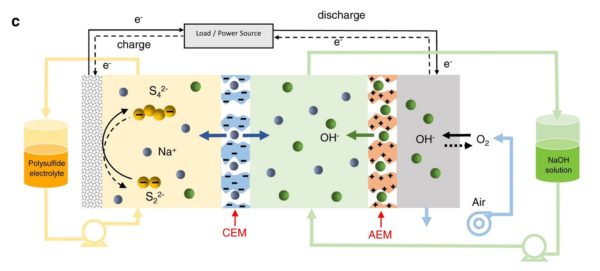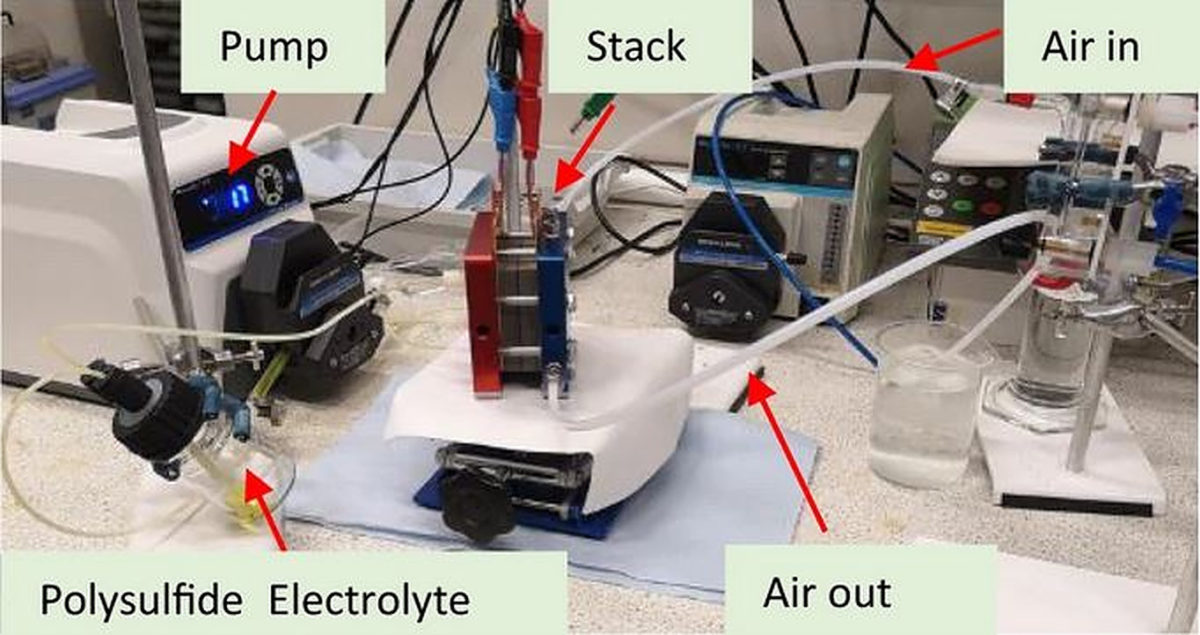Researchers at Imperial College London claim to have developed a stable alkaline-based hybrid polysulfide-air (PSA) redox flow battery (RFB) that can reduce “crossover” issues via a new dual-membrane-structured flow cell.
Crossover occurs during charging and recharging, when battery electrolyte components cross the membrane in the battery cell and the redoxmers – redox-active molecules that can store energy in the electrolytes of batteries – migrate to the wrong side of the device. This can cause capacity losses of up to 50%.
The chemistry of the battery is based on the polysulfide redox couple, which is known for its low costs and high energy density. It was chosen by the scientists as it was also used in previous research projects with PSA RFBs, and offered the lowest chemical cost of storage.
The UK group demonstrated the battery using a modular dual-membrane architecture that combined an anion-exchange membrane (AEM) and a cation-exchange membrane (CEM) in each individual cell.
“The dual-membrane design mitigates the crossover of polysulfide and enables the use of commercially available or synthetic polymer ion-exchange membranes (IEMs),” the scientists explained, noting that the design is able reduce membrane resistance and improve peak power density.

Image: Imperial College London, nature communications, Creative Commons License CC BY 4.0
The effectiveness of this dual-membrane structure was evaluated in real PSA RFB operations at all full battery cycling. It was found to be successful in mitigating the crossover of polysulfide ions toward the airside half-cell.
Popular content
“It also prevented high charging over-potentials of the CEM-based single-membrane PSA RFB. As a result, the dual-membrane-structured PSA RFB exhibited both higher voltage efficiency and high energy efficiencies,” the academics said.
The proposed PSA RFB achieved a maximum power density of 5.81 mW cm−2 at 55 C, relying on commercially available electrodes and membranes. The research team described the values as higher than the previous PSA RFB systems utilizing a precious metal catalyst and solid-state electrolyte separator.
The device also showed an average round-trip energy efficiency of 40% at 1 mA cm−2 over 80 cycles. The battery's energy and power costs were estimated at about $2.5/kWh and $1,600/kW and the academics believe there is significant room for further reduction.
The researchers described the battery in “A cost-effective alkaline polysulfide-air redox flow battery enabled by a dual-membrane cell architecture,” which was recently published in Nature Communications. “Future studies should focus on developing better electrodes, especially a highly active and reversible air electrode,” concluded the scientists.
This content is protected by copyright and may not be reused. If you want to cooperate with us and would like to reuse some of our content, please contact: editors@pv-magazine.com.



1 comment
By submitting this form you agree to pv magazine using your data for the purposes of publishing your comment.
Your personal data will only be disclosed or otherwise transmitted to third parties for the purposes of spam filtering or if this is necessary for technical maintenance of the website. Any other transfer to third parties will not take place unless this is justified on the basis of applicable data protection regulations or if pv magazine is legally obliged to do so.
You may revoke this consent at any time with effect for the future, in which case your personal data will be deleted immediately. Otherwise, your data will be deleted if pv magazine has processed your request or the purpose of data storage is fulfilled.
Further information on data privacy can be found in our Data Protection Policy.